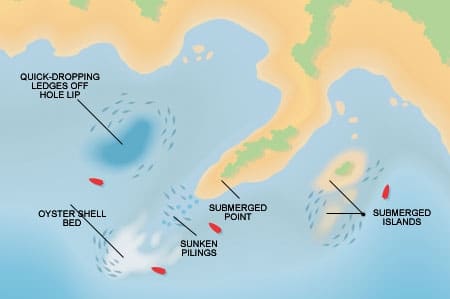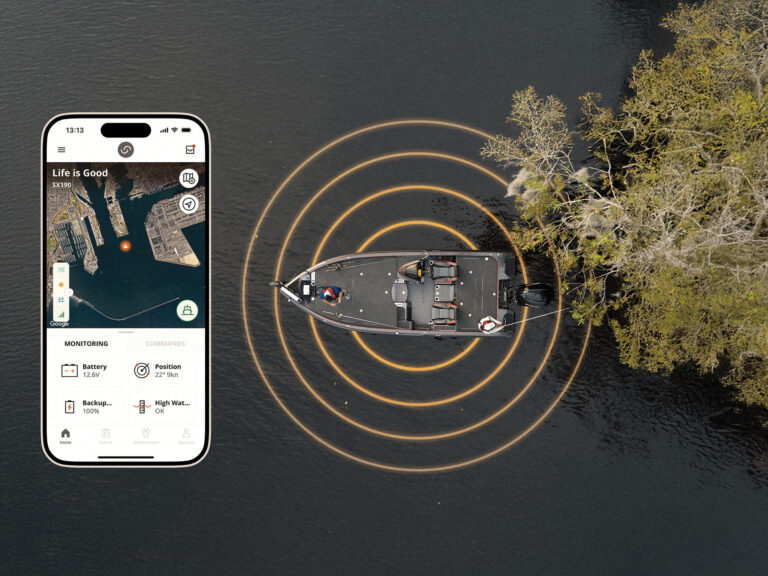
HOT BEDS: A depthfinder and a recent inshore chart will help anglers locate holes and structure.
Illustration: Bryan Christie
Inshore salt water habitat is composed of huge, imposing territory that can baffle even veteran anglers. Ordinarily, an inshore bay or sound can’t be covered in just a day or two of fishing. To work an entire bay effectively can take weeks if not years. However, there are shortcuts, if a savvy inshore angler knows what to look for. The following three treasures are among the most consistent producers of myriad inshore species.
1. Holes
A deep hole or depression in a bay or sound bottom can be a prime inshore fish-holding spot. Any hole featuring quick-dropping ledges should be fished thoroughly. If the hole is in deep water-over 20 feet-be sure to explore all depth levels when working the spot. Lures and baits should be dredged along the bottom and near the dropoffs. But also look for baitfish to suspend far above a hole; sportfish will hover nearby to feed on them. Holes can be good at any time of year, but they’re especially productive in winter and summer.
Some fish-attracting holes are created by underwater springs. The consistent temperatures they provide are attractive to many fish species during extreme weather conditions, as inshore waters become hot or cold.
Depthfinders used in combination with accurate, large-scale inshore charts are the fastest means to locate productive holes. However, keep in mind that the bottom of any large inshore body of water changes constantly due to wind and tides.
In shipping areas dredging and filling occurs almost constantly. Often, fill is removed from some regions to help shore up other inshore areas. During dredging operations, soil removed from shipping channels is often dumped into remote areas of sounds and bays. Such fill produces underwater islands and sandbars (as well as holes), creating ideal fish-attracting spots. It pays to take careful note of inshore dredging. Watch where fill is removed, and where it’s dumped. These may become hot fishing spots that aren’t charted.
2. Submerged Points
One of the easiest inshore hot spots to identify is a submerged point of land. Often, good points can be quickly located simply by observing shoreline terrain. Frequently, a point that tapers to the water on shore continues out into the water-sometimes for hundreds of yards. Underwater points can also be discovered by carefully studying charts. Slowly boating along shore with a watchful eye on your depthfinder is another easy way to discover submerged points.
The best points taper gradually from very shallow water to very deep water-preferably 20 or 30 feet. An ideal point would have a hard bottom of sand or clay, an extensive, broad, shallow flat with weed or shell beds, and on the clean, tapering point there would be periodic, well-defined dropoffs. Rock piles and sunken pilings make a point that much more attractive to fish.
Trolling is the easiest and fastest way of fishing points and learning the locations of weeds or sunken oyster beds. Use heavy spoons and diving plugs to work near the bottom while trolling to ¿feel¿¿ what’s down below.
3. Humps
An underwater island or hump is another hidden fish-holding treasure. Many of the best ones feature weedbeds, shell bars, docks or old pilings. This cover offers shelter for baitfish and in turn draws gamefish. Such places are sometimes marked by buoys, range markers or even lighthouses. Sometimes these places are remarkably small, only a rise in a sound or bay floor of a few feet, and not much bigger than a bedroom.
A picture-perfect submerged island is far from shore, surrounded by deep water with several ledges that taper to the depths. A hump one-half acre or so in size alongside a major river channel in a broad sound is a heaven-sent piece of fish habitat. On major waterways, these types of places may have been visible islands before settling deeper because of erosion, wind, tide and current.
The best humps normally are those few other anglers know about. So submerged islands far from shore or not shown on charts most likely offer the biggest schools of the most aggressive and stoutest gamefish.
Boat control is important when fishing humps, especially small ones. Wind, tide and current can botch a boat pass when casting to these spots, particularly for spooky fish in shallow water, such as snook, large seatrout and striped bass. Remember, gamefish holding on these places are usually aggressive and feeding. The first cast or two usually counts big time so do your best to get your offering into the strike zone quickly.
Successful marine fishermen have been catching myriad inshore species from hidden treasures for generations. By being able to identify prime inshore locations, then working such places through varying tide phases and seasons of the year, even a beginning inshore angler is destined to catch fish consistently.
Low Water Watch
Use moon tides to find the hottest hot spots.

|
|SEE SHELLS: Low tide will reveal fish-holding structure. Photo: Bob McNally|
Ebbing tides are great times to be on inshore waters searching for your next hidden-treasure hot spot. As you prospect, take special note of all exposed shell bars and old pilings. Carefully mark these locations on your chart and you will reap dividends when you return to fish it on an incoming tide. Both pilings and bars are rich in minute marine life, on which baitfish feed, and that brings bigger fish. Extremely low tides, which take place during full and new moons in spring, reveal the most submerged hot spots. I once found part of an sunken barge in a broad sound during a full moon low tide in May. The place has since become one of my best inshore spots giving up heavy catches of flounder, seatrout, red drum, even tarpon. The barge never was exposed during the low tide I located it. It showed as a large, dark shape on the otherwise sand-bottom, but only during full moon, low tide, in spring.
– B.M.









